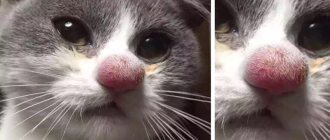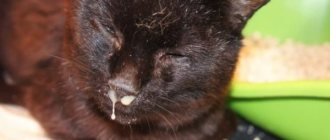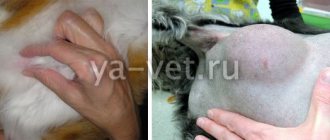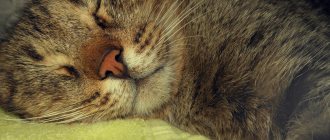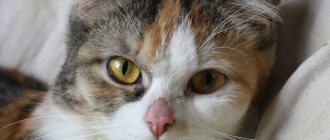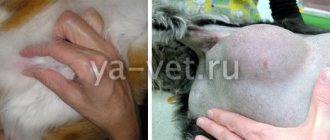If black dots appear on a cat’s nose, owners should not immediately worry. Such spots may be ordinary moles that people also have. But still, when a kitten has dark or white crusts around its mouth, it is recommended to show your pet to a veterinarian. Often the problem is associated with a skin disease and requires urgent treatment. At home, it is impossible to determine why a cat’s nose darkens, but a veterinary clinic will help determine the cause through a series of diagnostic examinations.
Crusts on a cat's nose
The cause of sores and crusts on the nose in cats can be malignant neoplasms. Most often, this is squamous cell carcinoma that occurs on the skin and mucous membranes in the head area. The cause of the disease is excessive exposure to the sun. It is more common in areas with a warm climate and plenty of sunny days.
The risk group includes individuals who are white or have large white spots on their bodies. The likelihood of malignant degeneration increases as the animal ages and with increasing time spent outside the home during hours of active UV radiation (from 10-11 a.m. to 4-5 p.m.).
Infections
Your cat's ears are going bald: causes of baldness and treatment options
Black crusts on the nose of cats, along with purulent discharge, can be symptoms of infectious diseases. To successfully treat an infection, you should first undergo tests (skin scraping and nasal swab) to determine the nature of the disease. In case of infection, the affected areas are treated with chlorhexidine (Miramistin) and lubricated with levomekol or other antibacterial agents as recommended by a doctor.
The color of a cat's nose always matches the color of its coat.
Important! If left untreated, infectious diseases can lead to complications or even death of the animal.
We should not forget that the health of mustachioed babies, like any children, is more fragile than that of adult animals, so a kitten’s dirty, crusty nose requires immediate action and timely treatment.
You should pay special attention to the health of kittens
Calcivirosis
Calcivirosis is a dangerous viral disease of cats. In addition to the nose and oral cavity, the infection can affect the respiratory, hematopoietic and nervous systems of animals, and the digestive organs. The disease is often severe, with symptoms appearing within 1-3 weeks, and about a third of those affected die. Survivors are able to shed the virus into the environment for up to 12 months. With stress, deterioration of living conditions, infection with VLK or FIV, a relapse of calicivirus occurs. If a secondary infection occurs, the mortality rate increases to 80%.
To avoid death, you need to show the animal to a veterinarian as soon as possible.
What are blackheads in cats and why are they dangerous?
Blackheads (acne) are clogged sebaceous glands. The characteristic dark head occurs when sebum oxidizes. The appearance of such symptoms in an animal may indicate disturbances in the functioning of the body, the presence of parasites. Such a problem cannot be ignored.
Black spots can trigger the occurrence of furunculosis, which is characterized by a purulent process occurring in the inflamed sebaceous gland. This condition is dangerous for the pet’s health and can contribute to the spread of infection. Outdoor animals are most susceptible to acne, but comedones can also occur in indoor cats.
Blackheads in cats are caused by blocked sebaceous glands.
Malfunctions of the sebaceous glands also appear in completely healthy pets. If a cat likes to play outside, a small amount of dirt gets into the mouth and, mixing with sebum, clogs the duct. Most often, comedones are localized on the chin.
Pet treatment
If your cat's nose begins to turn black, you should not self-medicate or waste time. Without special education, it is impossible to establish the exact reason why the nose turned black or discharge began. And not only the pet’s health, but also its life often depends on a timely visit to the veterinarian. It is useful to always have in your phone the contacts of a good veterinary clinic that is open 24 hours a day. One day this could save a pet's life.
Only a veterinarian can correctly diagnose and prescribe treatment for a cat.
Important! It should be remembered that water is much more important than food. The animal will live no more than two days without water, so you need to carefully monitor the pet and, if necessary, forcefully water it from a syringe, after immobilizing its paws.
Skin diseases
The cat is drooling: the main causes and treatment options
If you have a fungal infection, the crusts on your cat's nose may appear black or brown. Fungal diseases should be treated with antifungal agents, such as clotrimazole or fungin.
If a cat has black nasal discharge, this may be a consequence of otitis media or a symptom of a mite or fungus entering the sinuses and developing inflammation. To help your cat, you should get tested (scraping from the affected area) as soon as possible and, depending on the results, select a suitable treatment regimen from your veterinarian. To alleviate your pet’s condition, before receiving test results and starting treatment, you can carefully clean the nose and rinse it with warm water or chamomile decoction.
Black crusts under a cat's nose may be the result of a fungal infection.
Prevention of a runny nose
Several recommendations for the prevention of rhinitis in cats.
- The best prevention of a runny nose in a cat is timely vaccination. Although, unfortunately, even this does not provide a 100% guarantee of health, but it increases the chances.
- Do not allow the animal to become hypothermic. There should be no drafts in the house, and the pet’s bed should not be located in a cold place.
- Monitor your cat's immunity. Feed correctly (balanced), do not forget about fortification. However, remember that excess vitamins also have a bad effect on the animal’s condition.
- Eliminate possible allergens (hypoallergenic food, minimum chemicals when caring for animals, keep indoor plants away).
Care
Before the doctor arrives, the animal should be provided with complete rest. The nose should not be completely cleared of pus so as not to complicate the diagnosis. Excessive heat before the doctor arrives is also not recommended, as this can increase inflammation. After receiving a diagnosis, you should strictly follow all the veterinarian’s instructions for care, treatment and feeding, without skipping procedures.
In addition to direct treatment, a sick animal also needs the care and attention of its owner. You need to find time not only for medical procedures, but also for affectionate communication with your pet. You should also monitor the cleanliness of the animal’s fur, since due to weakness, most likely the cat will not have the strength to maintain it in proper form, and he will be very grateful to the owner for timely combing and cleansing the fur from pus, secretions or food debris.
For a sick animal, the care and attention of the owner is very important
If a cat has a black spot on its nose or any discharge from the nose or eyes, this is always a cause for concern. It should be remembered that people are responsible for those they have tamed. And the owner’s attentive attitude towards his pet is a guarantee of the animal’s health and longevity.
More serious reasons
There are several more serious reasons for a black spot on your cat's nose. Sometimes a bacterial infection can cause your cat's mucous membranes to change color, in which case your cat will likely need treatment for a respiratory infection.
In this case, the black color may be blood again, but this is usually due to irritation of the nose and respiratory tract and may be a sign that your cat is in trouble.
© shutterstock
Another reason is feline herpes. Although it may seem incredible, the good news is that many cats are completely unaffected by herpes and cannot be infected with the herpes virus.
However, if one of your cats has herpes, chances are every other cat in your home also has the virus. It is important to prevent uninfected cats from coming into contact with infected ones, including keeping the cat indoors only after diagnosis.
Herpes does mean that you may have to wipe off the discharge, and your veterinarian may prescribe some cleaning products to keep the problem under control.
Of course, if you are unsure why your cat is having nasal discharge (of any color), especially if the discharge is sudden or more than usual, you should take your cat to the vet. Taking her to the vet is the best way to make sure your cat remains safe and healthy.
As a general rule, your cat's nose should be clean and dry. Some cats have wet noses, but this is not very common. If you notice changes in your cat's nose, it's best to get a physical exam just in case.
Injuries
The cat's nose is a very sensitive and delicate organ; it is naturally constantly moisturized, for this reason its damaged skin takes a long time to heal. If there is no doubt that the cause of the appearance of black crusts on the nose is an injury, then the cat will not require special treatment. After the damaged tissue is restored, the crust will fall off on its own. Only if weeping wounds or ulcers appear, the nose should be treated with an antiseptic.
Black cats will always have black noses too.
When should an owner sound the alarm?
Black dots on the nose that have developed for pathological reasons, due to hormonal, systemic disruptions in the body, may be accompanied by the following symptoms:
- itching, scratching on the face;
- restless behavior;
- the appearance of a skin rash, bald patches on the body;
- poor coat quality;
- dry nose;
- unstable temperature;
- decreased activity;
- refusal of food;
- increased thirst;
- skin inflammation;
- the appearance of scabs, dry crusts on the nose;
- swelling.
If dark dots, spots of different diameters, increase in size, are distributed throughout the animal’s body, ulcers are noticeable, or other signs that are not typical for a healthy cat, it would be a good idea to show your pet to a veterinarian, since such symptoms may signal the development of neoplasia and skin cancer.
Malignant pigment spots have a dirty yellow, brown, dark brown color with a reddish tint, and uneven edges. They may protrude somewhat above the surface of the skin. In severe cases, blackheads can spread throughout the pet's entire body.
But! A white nose can be an alarming symptom!
If your cat's nose discolors from pink to white, it may be a sign of dehydration or anemia (decreased hemoglobin levels in the blood, usually with a decrease in the number of red blood cells). Anemia itself is not a disease, but it is considered one of the symptoms of various pathologies.
First of all, you should pay attention to your pet's gums. If, instead of a healthy pink color, they also have a pale appearance, this is a reason to urgently contact a veterinarian to rule out any serious problems or catch the disease as early as possible for successful treatment.
Anemia can be caused by an unbalanced diet and lack of microelements, or be a sign of leukemia, a viral disease, pathology of internal organs (for example, renal failure), etc.
If the whitening of the nose is accompanied by other symptoms (diarrhea, apathy, lethargy, loss of appetite and weight), medical intervention is required immediately!

